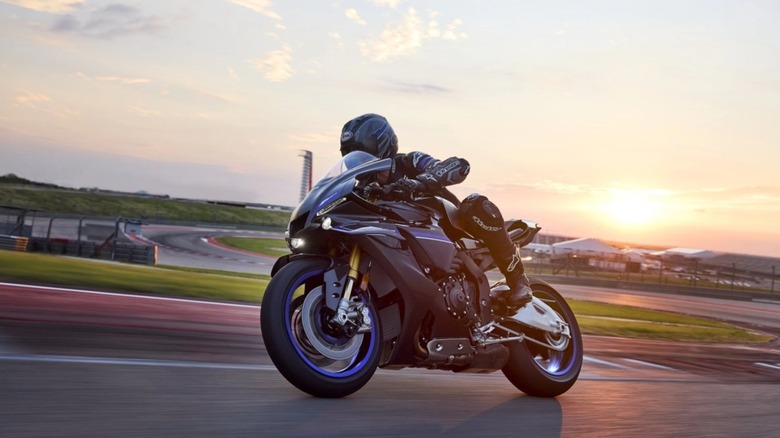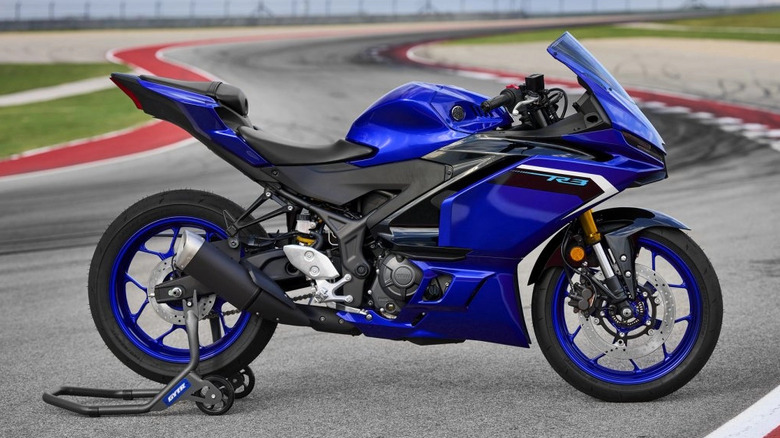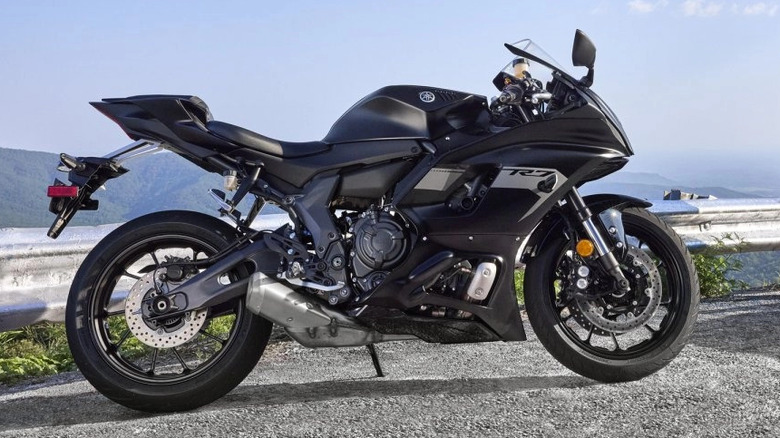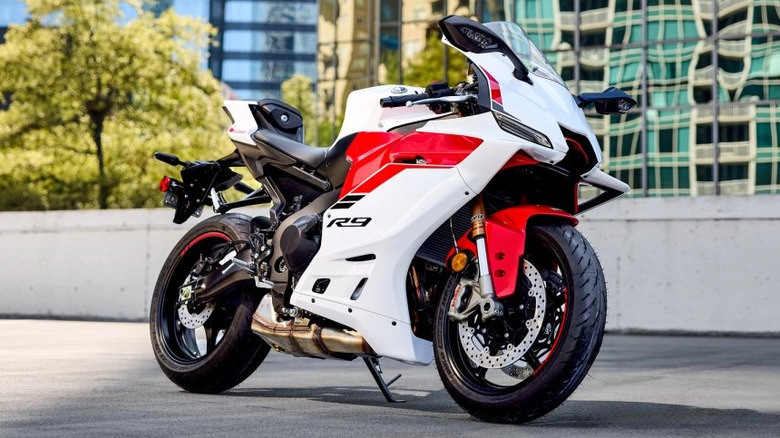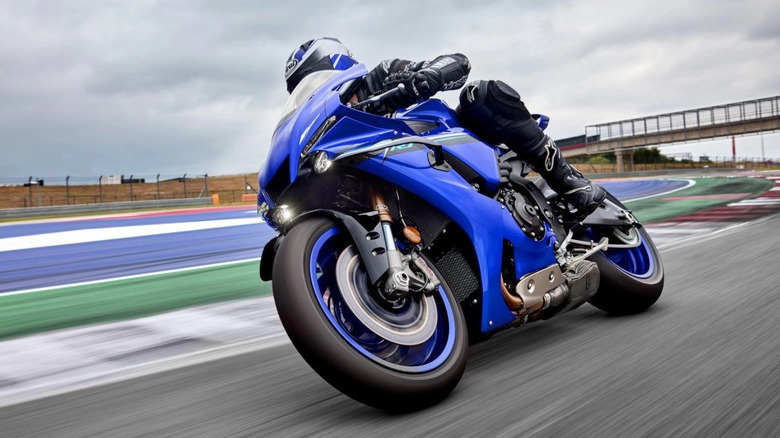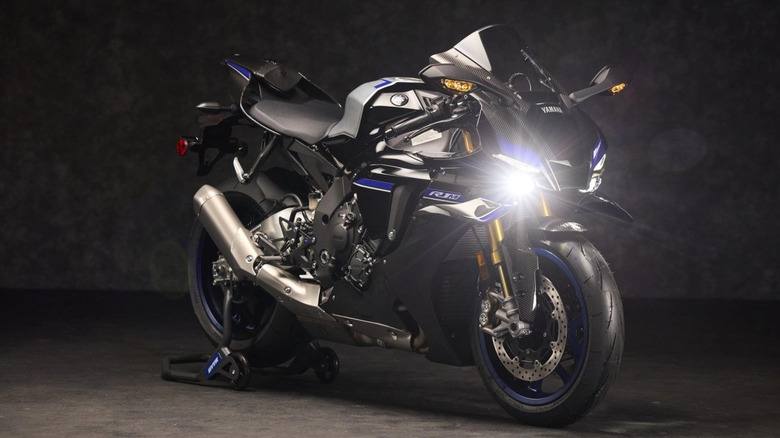Every Yamaha Sport Bike You Can Buy, Ranked From Cheapest To Most Expensive
There are few sport bike lines with as much heritage as Yamaha's YZF family of motorcycles. Whether it's the iconic YZF-R1, the mid-priced YZF-R7, or the entry-level YZF-R3, Yamaha has released many excellent sport bikes over the years, catering to almost every kind of rider out there. Well, those who want a sport bike, at least.
That lineage continues to this day, with five models in the current YZF family to choose from, including a brand-new Yamaha model joining the family for 2025: the YZF-R9 slots between the YZF-R7 and the race-ready YZF-R1. Altogether, this a small lineup for sure, especially compared to Kawasaki's wide range of Ninja sport bikes. However, what Yamaha gives up in quantity it sure makes up for in quality: The YZF-R1 is commonly hailed as one of the best high-performance motorcycles out there, and even the 300cc YZF-R3 has consistently earned high praise from the motoring press.
If you're in the market for a sport bike, you could do a lot worse than consider one of Yamaha's offerings. Here's a quick look at all five models, listed from most expensive to least (not including destination fees).
5. Yamaha YZF-R3 — $5,499
As you might expect, we start with the baby of the Yamaha YZF lineup, the YZF-R3. Sporting a manageable 321cc engine and a handful of rider-friendly features, the R3 is a great starting point for those trying to get their feet wet in the world of sport bikes, especially considering the affordable $5,499 MSRP.
Now, to be clear, the YZF-R3 isn't going to knock your socks off with its straight-line speed or power, but that's not what it's for. It's a lightweight, 373-pound motorcycle that handles well and is easy (and comfortable) to ride, both of which likely matter more than outright power for those getting familiar with what sport bikes have to offer.
Those of you considering a YZF-R3 in 2025 will be pleased to know that Yamaha has made a range of improvements for 2025 that should make it an even friendlier bike to ride. The 2025 R3 has a narrower seat and slimmer bodywork, which should help improve riding ergonomics even more. Yamaha has also specced an Assist & Slipper clutch, which reduces clutch lever weight and improves stability and smoothness during downshifts. Modern smartphone connectivity is now available, too, so you'll be able to keep track of notifications and ride data via Yamaha's Y-Connect app; it's nothing groundbreaking, sure, but it's sure handy, especially given some of you may want to take advantage of the R3's surprisingly decent touring capabilities.
4. Yamaha YZF-R7 — $9,199
Up next is the Yamaha YZF-R7, which debuted in 2022. The bike came a couple of years after Yamaha had to discontinue the YZF-R6 in 2020 due to European emissions regulations. Despite having a larger 689cc engine, the $9,199 R7 is significantly cheaper than the R6, which had a roughly $12,000 list price, making for a more comfortable step up — financially, at the very least — from the R3.
The R6 had a high-revving inline-four engine, while the R7's CP3 engine is a tamer two-cylinder motor — hardly a straightforward replacement. But that doesn't mean it's a bad bike. The R7 shares its core platform with the legendary Yamaha MT-07, with tweaks to bring the MT-07's upright, naked bike geometry more in line with what customers expect from supersport bikes.
What you get is an accessible bike that manages to entertain on the track while remaining reasonably beginner-friendly — the best of both worlds, really. The price may be a big leap over the R3, but this could be great deal for those not quite ready to step up to Yamaha's big-boy supersport offerings. Unlike the R3, the R7 is much the same for 2025, with no major upgrades and the same MSRP as the 2024 model.
3. Yamaha YZF-R9 — $12,499
Yamaha's YZF-R9 is an all-new supersport motorcycle for 2025. It slots between the R7 and R1, offering a mid-point between the former's relatively accessible nature and the latter's 200-hp high-performance craziness.
The R9 is cut from the same cloth as the R3, with a three-cylinder 890cc CP3 engine sourced from the MT-07's bigger brother, the "John Wick"-approved Yamaha MT-09. The R9 isn't a straightforward replacement for the high-revving four-cylinder R6, either. Yamaha designed it to be a great performer on the road capable of carving up bends — but which owners could also take to the track. In that sense, it's the inverse of the R6, which was essentially a race-replica bike that just happened to be road-legal.
To that end, the R9 offers niceties like electronic rider aids — R1-derived traction, brake, lift, and slide control, all with adjustable modes and assist levels — and modern smartphone connectivity, along with street-minded ergonomics. You'll still have to live with the typical supersport rider triangle, of course, but the footpegs are lower compared to the R1, which should make the R9 easier to live with day to day. The R9 has yet to make its way into reviewers' hands at the time of writing, so we can't say whether the company has succeeded in its aims. That said, all signs point to another solid modern Yamaha sport bike at a decent price.
2. Yamaha YZF-R1 — $18,999
Now we come to the iconic Yamaha YZF-R1, the most long-lived member of the current Yamaha supersport stable. The YZF-R1 essentially defined the supersport segment when it debuted in 1998, with its combination of excellent handling and powerful 1000cc engine taking sport bikes to a whole new level. Things haven't changed much in the 26 years since, either.
Sure, the R1 is no longer the top dog in Yamaha's supersport range — the YZF-R1M now holds that accolade — but that doesn't mean that it's lost any of its edge over the years. It's still a blisteringly fast motorcycle, with its 197 hp and 83 lb-ft of torque allowing the R1 to hit the artificially limited 186 mph speed limit of most high-performance bikes.
And the R1 isn't just a raw straight-line speed merchant, either: Yamaha introduced rider aids to the bike in 2015 before further refining the bike's tech and features in 2020 with additions such as an updated suspension and a ride-by-wire throttle, which allowed for new rider assists and power management modes. The 2025 model is — wisely — pretty much more of the same, albeit with a higher $18,999 price. The company is also discontinuing the road-going R1 in Europe after 2025 due to emissions regulations, but U.S.-based riders need not worry: Yamaha will keep building the R1 for all other markets, at least for the foreseeable future.
1. Yamaha YZF-R1M — $27,699
Can you have too much of a good thing? We're not entirely sure, but the Yamaha YZF-R1M is a great example of how we're not quite there yet — at least if we're talking about high-performance supersport bikes. The R1M debuted in 2015 as a souped-up version of the R1, with an eye-watering $27,699 price to match, of course.
To be clear, the R1M isn't faster or more powerful than the R1. After all, the non-M version was already butting up against the 186-mph top speed to which motorbike manufacturers have decided to limit their bikes. The differences between the R1 and R1M lie in other areas, notably the body and suspension.
The R1M has carbon fiber bodywork, which looks great and gives the bike a racy aesthetic. It's a look that the new-for-2025 front winglets inspired by Yamaha's MotoGP efforts enhance even more. The carbon fiber doesn't help weight, though, as the YZF-R1M is actually a little heavier than the R1 at 452 pounds (versus 448). Beyond that, the R1M has a trick Öhlins electronic suspension, which works with the bike's inertial measurement unit (IMU) to adjust itself in real-time. Track fiends also have access to a GPS-powered data logging system, which tracks the bike's data and lap times. The result is a bike that, according to reviews, feels like a genuine race bike that's a cut above the R1. But you'd expect that, given the nearly-$9,000 price difference.
